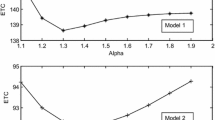Abstract
This paper examines the transient behaviour of a two-stage multi-product production system with an interstage buffer. The system is described by a stochastic method and is analysed by employing the state-space model and regenerating point technique. Explicit expressions are obtained for certain essential system characteristics and a cost analysis is carried out using some of the characteristics. A particular case is investigated to illustrate some features of this production system.
Similar content being viewed by others
References
T. ALTIOK (1982) Approximate analysis of exponential tandem queues with blocking. European J. Operat. Res., 11, 390–398.
A. BIROLINI (1985) On the use of stochasitc processes in modelling reliability problems. Lecture notes in Economics and Mathematical systems, Springer-Verlag, Berlin.
E. CINLAR (1975), Introduction to Stochastic Processes, Prentice-Hall Inc., New Jersey.
M.N. GOPALAN AND T.K. RAMESH (1989) Cost benefit analysis of queues in tandem with Buffer-I. Internationa! Journal of Management and Systems. 5(1), 37–41.
M.N. GOPALAN AND T.K. RAMESH (1989) Cost benefit analysis of queues in tandem with Buffer-II. International Journal of Management and Systems. 5(2), 123–126.
F. S. HILLIER, AND R.W. BOLING (1967) Finite queues in series with exponential or Erlang service times — A numerical approach. Operations Research. 15, 286–303.
G.C HUNT (1956) Sequential arrays of waiting lines. Operations Research. 4(6), 674–683.
T. IYAMA (1979) The efficiency of two-stage series lines. J. Operations Research Soc. Japan. 22(4), 321–337.
J.G. JONES (1961) On the numerical solution of convolution integral equations and systems of such equations. Mathematics of Computation. 15, 132–141.
M.F. NEUTS (1968) Two queues in series with a finite, intermediate waiting room. J. Appl. Prob. 5, 123–142.
M.F. NEUTS (1970) Two servers in series studied in terms of a Markov renewal branching process. Adv. Appl. Prob. 2, 110–149.
N.P. RAO (1975) Two-stage production system with intermediate storage. AIIE Transactions. 7(4), 414–421.
UMEATSU, K, NISHIDA, T AND KOWADA, M. (1984), Some applications of semi-regenerative process to two unit warm standy system, Microelectronics and Reliability, 24(5), pp.965–978.
Author information
Authors and Affiliations
Rights and permissions
About this article
Cite this article
Gopalan, M.N., Kumar, U.A. Busy Period Analysis of A Two-Stage Multi-Product System with Interstage Buffer. OPSEARCH 36, 284–299 (1999). https://doi.org/10.1007/BF03398582
Published:
Issue Date:
DOI: https://doi.org/10.1007/BF03398582




